
Eusthenopteron is a genus of prehistoric sarcopterygian which has attained an iconic status from its close relationships to tetrapods. Early depictions of this animal show it emerging onto land; however, paleontologists now widely agree that it was a strictly aquatic animal. The genus Eusthenopteron is known from several species that lived during the Late Devonian period, about 385 million years ago. Eusthenopteron was first described by J. F. Whiteaves in 1881, as part of a large collection of fishes from Miguasha, Quebec. Some 2,000 Eusthenopteron specimens have been collected from Miguasha, one of which was the object of intensely detailed study and several papers from the 1940s to the 1990s by paleoichthyologist Erik Jarvik.

The Tetrapodomorpha are a clade of vertebrates consisting of tetrapods and their closest sarcopterygian relatives that are more closely related to living tetrapods than to living lungfish. Advanced forms transitional between fish and the early labyrinthodonts, such as Tiktaalik, have been referred to as "fishapods" by their discoverers, being half-fish, half-tetrapods, in appearance and limb morphology. The Tetrapodomorpha contains the crown group tetrapods and several groups of early stem tetrapods, which includes several groups of related lobe-finned fishes, collectively known as the osteolepiforms. The Tetrapodomorpha minus the crown group Tetrapoda are the stem Tetrapoda, a paraphyletic unit encompassing the fish to tetrapod transition.
Kenichthys is a genus of sarcopterygian fish from the Devonian period, and a member of the clade Tetrapodomorpha. The only known species of the genus is Kenichthys campbelli, the first remains of which were found in China in 1993. The genus is important to the study of the evolution of tetrapods due to the unique nature of its nostrils, which provide vital evidence regarding the evolutionary transition of fish-like nostrils to the tetrapod choanae.

Rhizodontida is an extinct group of predatory tetrapodomorphs known from many areas of the world from the Givetian through to the Pennsylvanian - the earliest known species is about 377 million years ago (Mya), the latest around 310 Mya. Rhizodonts lived in tropical rivers and freshwater lakes and were the dominant predators of their age. They reached huge sizes - the largest known species, Rhizodus hibberti from Europe and North America, was an estimated 7 m in length, making it the largest freshwater fish known.
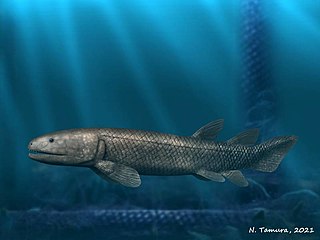
Megalichthyiformes is an extinct clade of basal tetrapodomorphs which first appeared during the Devonian period. It was named in 2010 by Michael I. Coates and Matt Friedman, who defined it as a stem-based taxon containing all tetrapodomorphs closer to Megalichthys than to Eusthenopteron.

Rhizodus is an extinct genus of basal, finned tetrapodomorphs. It belonged to Rhizodontida, one of the earliest-diverging tetrapodomorph clades. Two valid species have been described, both of which lived during the Early Carboniferous epoch. The type species R. hibberti is known from the Viséan stage of the United Kingdom, whereas the species R. serpukhovensis is from the Serpukhovian of Russia. Some fossils referred to the genus Rhizodus have also been found in North America.

Elpistostege is an extinct genus of finned tetrapodomorphs that lived during the Frasnian age of the Late Devonian epoch. Its only known species, E. watsoni, was first described in 1938 by the British palaeontologist Thomas Stanley Westoll, based on a single partial skull roof discovered at the Escuminac Formation in Quebec, Canada.
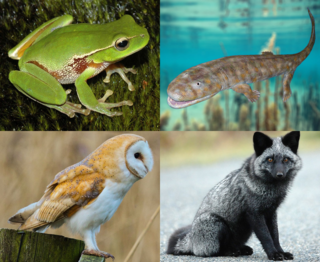
Stegocephali is a clade of vertebrate animals containing all fully limbed tetrapodomorphs. It is equivalent to a broad definition of the superclass Tetrapoda: under this broad definition, the term "tetrapod" applies to any animal descended from the first vertebrate with four limbs each with five digits in the extremity (pentadactyly), rather than fins of their sarcopterygian relatives.
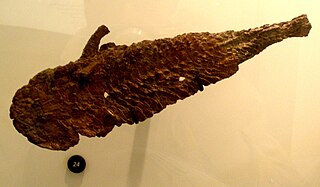
Megalichthyidae is an extinct family of tetrapodomorphs which lived from the Middle–Late Devonian to the Early Permian. They are known primarily from freshwater deposits, mostly in the Northern Hemisphere, but one genus (Cladarosymblema) is known from Australia, and the possible megalichthyid Mahalalepis is from Antarctica.

Osteolepididae is a family of primitive, fish-like tetrapodomorphs that lived during the Devonian period. The family is generally thought to be paraphyletic, with the traits that characterise the family being widely distributed among basal tetrapodomorphs and other osteichthyans. Some of genera historically placed in Osteolepididae have more recently been assigned to the family Megalichthyidae, which appears to be a monophyletic group.
Cladarosymblema is an extinct genus of megalichthyid tetrapodomorphs which lived in Australia during the Early Carboniferous.
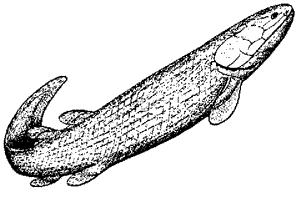
Ectosteorhachis is an extinct genus of megalichthyid tetrapodomorphs that lived during the Permian period. Ectosteorhachis lived in freshwater environments.
Dolichopareias is an extinct genus of adelospondyl tetrapodomorph.

Oestocephalus is an extinct genus of aïstopod tetrapodomorphs that lived during the Carboniferous period. Fossils have been found in the Czech Republic, and in Ohio and Illinois in the United States. It is the type genus of the family Oestocephalidae, although it used to be assigned to the family Ophiderpetontidae, which is now considered paraphyletic. It was named by Edward Drinker Cope in 1868 and now contains two species, O. amphiuminus and O. nanum.

Palaeomolgophis is an extinct genus of eel-like adelospondyl tetrapodomorphs containing a single species—Palaeomolgophis scoticus. Their limbs are much reduced, and they were probably fully aquatic.
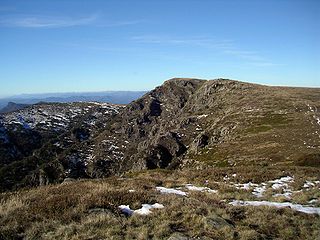
Marsdenichthys is an extinct genus of Devonian tetrapodomorph. Fossils have been found from Mount Howitt in Victoria, Australia from strata that are Givetian-Frasnian in age. Mount Howitt is an important site that has been the source of many tetrapodomorph fossils, including Beelarongia and Howittichthys, both of which were first described from the locality.

Oestocephalidae is an extinct family of Late Carboniferous aistopod tetrapodomorphs. Fossils have been found from Ohio, Illinois, and Colorado in the United States; England; and the Czech Republic. It includes the genera Coloraderpeton and Oestocephalus. Oestocephalids have robust skulls and narrow, rounded snouts. They possess heavily ossified gastralia and dorsal osteoderms. Like other aïstopods, oestocephalids were elongate, having approximately 110 vertebrae. Oestocephalidae was named in 2003, with the type species being Oestocephalus amphiuminus.

Eotetrapodiformes is a clade of tetrapodomorphs including the four-limbed vertebrates and their closest finned relatives, two groups of stem tetrapods called tristichopterids and elpistostegalids.

Tungsenia is an extinct genus of basal tetrapodomorph bony fish known from the ~409 mya of northeastern Yunnan Province, China. Its remains were discovered in the Posongchong Formation. It is the basalmost known tetrapodomorph.

Elginerpetontidae is an extinct family of basal stegocephalian tetrapodomorphs which lived in Europe during the Frasnian stage of the Late Devonian epoch. It contains the genera Elginerpeton, Obruchevichthys and Webererpeton.





















